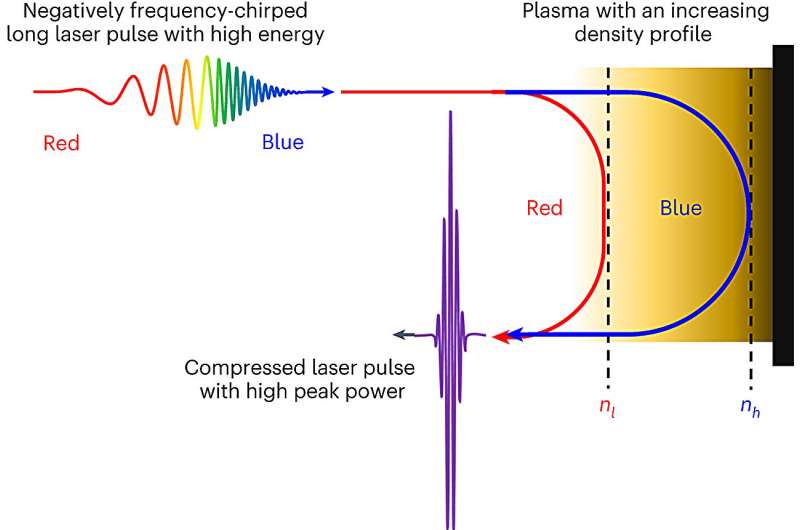This article has been reviewed according to Science X's editorial process and policies. Editors have highlighted the following attributes while ensuring the content's credibility:
fact-checked
peer-reviewed publication
trusted source
proofread
Laser pulse compression by a density gradient plasma for exawatt to zettawatt lasers

A new method of creating laser pulses, more than 1,000 times as powerful as those currently in existence, has been proposed by scientists in the UK and South Korea.
The scientists have used computer simulations in joint research to demonstrate a new way of compressing light to increase its intensity sufficiently to extract particles from vacuum and study the nature of matter. To achieve this the three groups have come together to produce a very special type of mirror—one that not only reflects pulses of light but compresses them in time by a factor of more than two hundred times, with further compression possible.
The groups from the University of Strathclyde, UNIST and GIST propose a simple idea—to use the gradient in the density of plasma, which is fully ionized matter, to cause photons to "bunch," analogous to the way a stretched-out group of cars bunch up as they encounter a steep hill. This could revolutionize the next generation of lasers to enable their powers to increase by more than one million times from what is achievable now.
The new method of compressing laser pulses in plasma is published in the journal Nature Photonics.
The highest power lasers in the world have a peak power of around 10 petawatts. To put this in context, 173 petawatts (173 × 1015 W) of sunshine reaches the Earth's upper atmosphere, and about one third of this reaches the Earth's surface. A petawatt is 1015 W, an exawatt is 1018 W and a zettawatt is 1021 W. The sun produces 4x1026 W of power or 400,000 zettawatts.
High power lasers produce pulses of light with durations that are very short—usually several femtoseconds (one femtosecond is 10-15 seconds), which is achieved using a technique called chirped pulse amplification (CPA). CPA involves pulse compression, which concentrates laser pulse energy into a short time, thus increasing its peak power by many orders of magnitude.
Professor Dino Jaroszynski, of the University of Strathclyde's Department of Physics, said, "An important and fundamental question is what happens when light intensities exceed levels that are common on Earth. High power lasers allow scientists to answer basic questions on the nature of matter and the vacuum and explore what is known as the intensity frontier.
"Applying terawatt to petawatt lasers to matter has enabled the development of next-generation laser-plasma accelerators, which are thousands of times smaller than conventional accelerators. Providing new tools for scientists is transforming the way science is done. We have set up the Scottish Center for the Application of Plasma-based Accelerator, (SCAPA), at the University of Strathclyde to push applications based on high power lasers forward."
Professor Min Sip Hur, of UNIST, said, "The results of this research are expected to be applicable in various fields, including advanced theoretical physics and astrophysics. It can also be used in laser fusion research to help address the energy issues facing humanity. Our combined Korean and UK teams plan to experimentally test the ideas in the lab."
Professor Hyyong Suk, of GIST, said, "Plasma can perform a role similar to traditional diffraction gratings in CPA systems but is a material that cannot be damaged. It will therefore enhance traditional CPA technology by including a very simple add-on. Even with plasma of a few centimeters in size, it can be used for lasers with peak powers exceeding an exawatt."
Exawatts and zetawatts seem like a lot of power, which they certainly are, but by simply focusing the laser pulse to a small spot using a lens or curved mirror, to concentrate its energy, its intensity can be increased by a huge amount. In analogy with compressing a laser pulse in time to a short duration, the same thing can be done in space by compressing the pulse spatially that is, focus it to a small spot. So compression, in a very general way—in space or time—allows an increase in the intensity of a laser pulse. Spatial compression can easily be tested using a lens to focus sunlight onto a piece of paper; it will spontaneously combust.
Matter undergoes various transformations as the intensity is increase. For example, air is ionized above intensities of 1010—1012 W/cm2 for visible light wavelengths and when electrons are subject to lasers of intensities above 1018 W/cm2, they approach the speed of light and this leads into the realm of relativistic optics.
At intensities of 1024 W/cm2 and above, protons approach the speed of light and particles experiencing intense laser fields react to their own radiation fields, which is the current intensity frontier in physics. At intensity above 1029 W/cm2, which is known as the Schwinger limit, particles are produced directly from vacuum—light can be directly transformed into matter. This requires exawatt to zettawatt lasers.
Understanding the nature of matter and vacuum at intensities above 1024 W/cm2 is among the outstanding challenges of modern physics. High power lasers also enable the study of astrophysical phenomena in the laboratory, providing unique glimpses into the interior of stars and the origin of the universe.
More information: Min Sup Hur et al, Laser pulse compression by a density gradient plasma for exawatt to zettawatt lasers, Nature Photonics (2023). DOI: 10.1038/s41566-023-01321-x
Journal information: Nature Photonics
Provided by University of Strathclyde, Glasgow




















